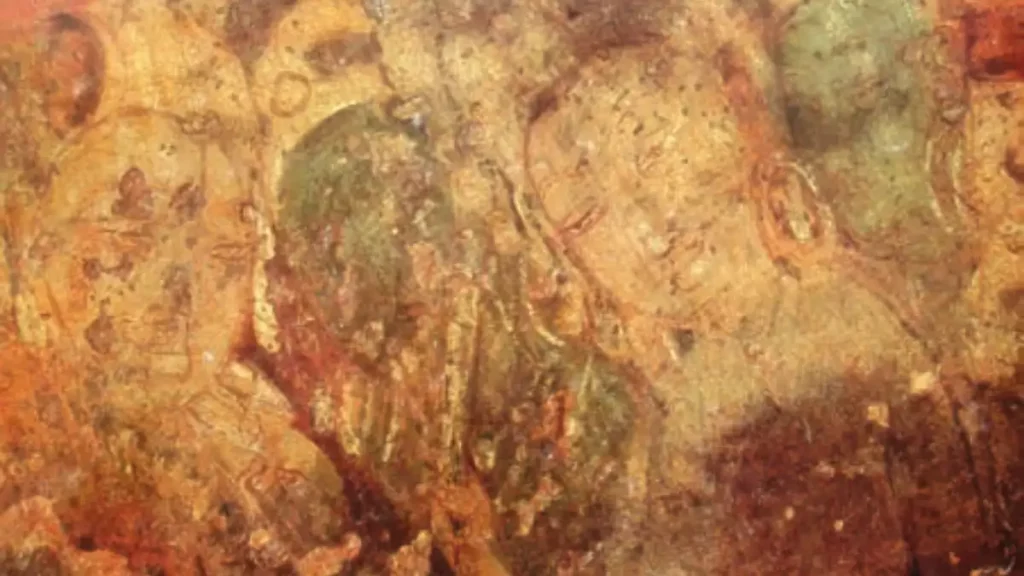- Indian paintings can be broadly classified as murals and miniatures.
- Murals are large works executed on the walls of solid structures, as in the Ajanta Caves and the Kailashnath temple in Ellora.
- Miniature paintings are executed on a very small scale for books or albums on perishable material such as paper and cloth. Prime examples are the Rajasthani and Mughal miniatures.
Mural Paintings & Cave Paintings
- The work on the walls or a solid structure are referred to as Murals. These have existed in India since ancient times and can be dated between 10th century BC and 10th century AD.
- The evidence of such paintings can be found at several locations in India. The beauty and the exquisiteness of mural paintings can be seen in places like Ajanta, Armamalai Cave, Ravan Chhaya Rock Shelter, Bagh Caves, Sittanavasal Caves and Kailasha Temple in Ellora.
- Most of the mural paintings are either in natural caves or in rockcut chambers. The paintings follow a theme, the most common being Hindu, Buddhist and Jain. Apart from this, mural paintings were also made to adorn any mundane premise. An example of such a work can be seen in the ancient theatre room in Jogimara Caves.
Technique of Mural Paintings
- The technique and process of making Indian wall paintings has been discussed in a special chapter of the Vishnudharamotaram, a Sanskrit text of the 5th / 6th century CE.
- Most of the colours were locally available. Brushes were made up from the hair of animals, such as goat, camel, mongoose, etc.
- The ground was coated with an exceedingly thin layer of lime plaster over which paintings were drawn in water colours. In true fresco method the paintings are done when the surface wall is still wet so that the pigments go deep inside the wall surface.
- The other method of painting is known as tempora or fresco-secco. It is a method of painting on the lime plastered surface which has been allowed to dry first and then drenched with fresh lime water.
- On the surface thus obtained the artist proceeded to sketch out his composition. This first sketch was drawn by an experienced hand and subsequently corrected in many places with a strong black or deep brown line when the final drawing was added.
Ajanta Cave Paintings
- Ajanta Cave Paintings are the one of the oldest surviving murals of Indian sub-continent, Ajanta caves were carved between 2nd century BC to 5th century AD out of volcanic rocks.
- It consists of a set of 29 caves, carved in a horse-shoe shape.
- These Buddhist caves are quite popular for their exquisite mural paintings. Murals in Cave no. 9 and 10 belong to the Shunga period, while the rest belong to the Gupta period. The paintings in Cave no. 1 and 2 are the most recent of the caves in Ajanta.
- The walls of the caves have both murals and fresco paintings (painted on wet plaster). They use tempera style, i.e. use of pigments.
- The paintings portray human values and social fabric along with styles, costumes and ornaments of that period. The emotions are expressed through hand gestures. The unique feature of the paintings is that each female figure has a unique hairstyle. Even animals and birds are shown with emotions.
- The common themes of these paintings range from Jataka stories to life of Buddha to elaborate decorative patterns of flora and fauna. Graceful poses of humans and animals adorn the walls of the caves. The medium of painting was vegetable and mineral dyes. The outline of the figures is in red ochre, with contours of brown, black or deep red.
- Some important paintings at Ajanta are:
- The earliest paintings at Ajanta are in cave No. IX and X of which the only surviving one is a group on the left wall of cave X. This portrays a king with attendants in front of a tree decked with flags.
- The King has come to the sacred Bodhi tree for fulfilling some vow connected with the prince who is attending close to the king.
- Scenes from the Jataka stories of the Buddha’s former lives as a Bodhisattva, the life of Gautam Buddha, etc.
- Paintings of various Bodhisattvas in tribhanga pose in Cave No. 1: Vajrapani (protector and guide, a symbol of Buddha’s power), Manjusri (manifestation of Buddha’s wisdom) and Padmapani (Avalokitesvara) (symbol of Buddha’s compassion).
- The Dying Princess in Cave No. 16.
- Scene of Shibi Jataka, where King Shibi offered his own flesh to save the pigeon.
- Scene of Matri-Poshaka Jataka where the ungrateful person saved by an elephant, gives out his whereabouts to the king.
- In cave No. XVII painted probably in circa 6th century CE is a painting representing Buddha’s visit to the door of Yashodhara’s abode in the city of Kapilavastu while she herself has come out with her son Rahula to meet the Great King.
- A beautiful depiction of a feminine beauty is the painting of Maya Devi, the mother of the Buddha.
- Along-side these Buddhist paintings there are also a few Brahmanical figures of iconographic interest: Indra, a Hindu divinity, is depicted flying amid clouds together with celestial nymphs holding musical instruments.
- An example of ceiling decoration is from cave No. XVII and belongs to circa 6th century A.D. The pink elephant is from the same decorative painting ‘and can be seen in detail.
- The earliest paintings at Ajanta are in cave No. IX and X of which the only surviving one is a group on the left wall of cave X. This portrays a king with attendants in front of a tree decked with flags.
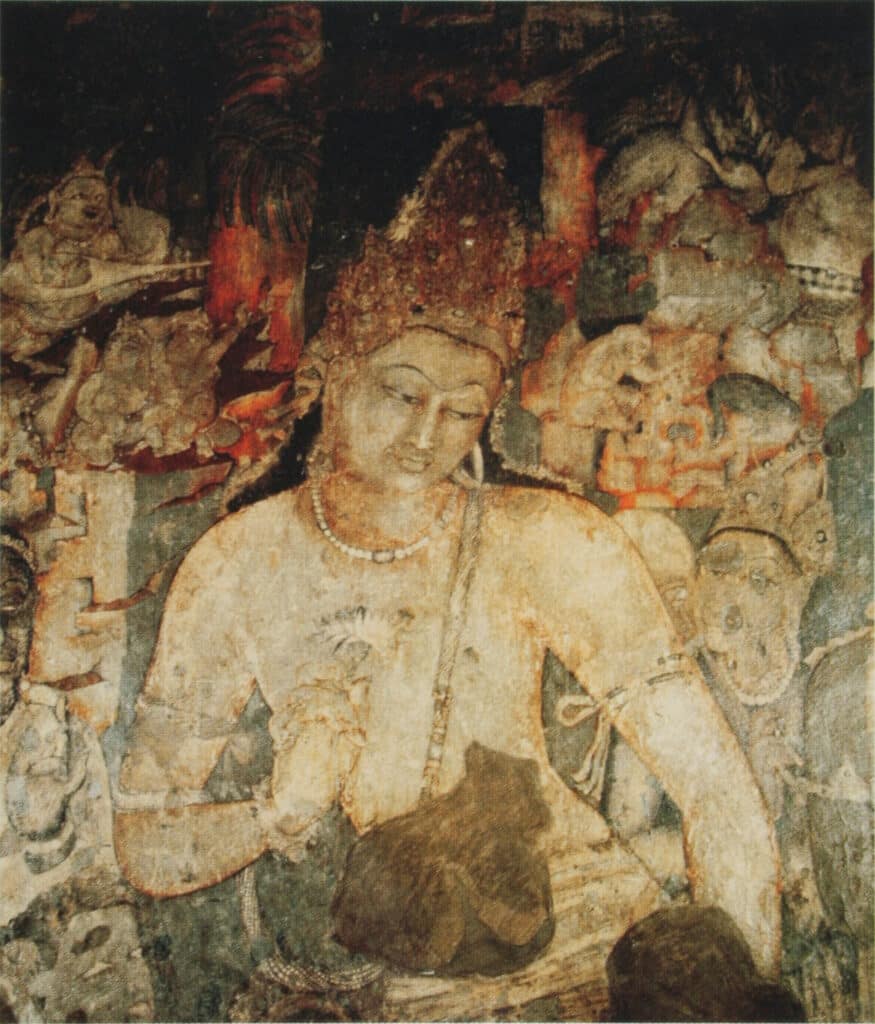
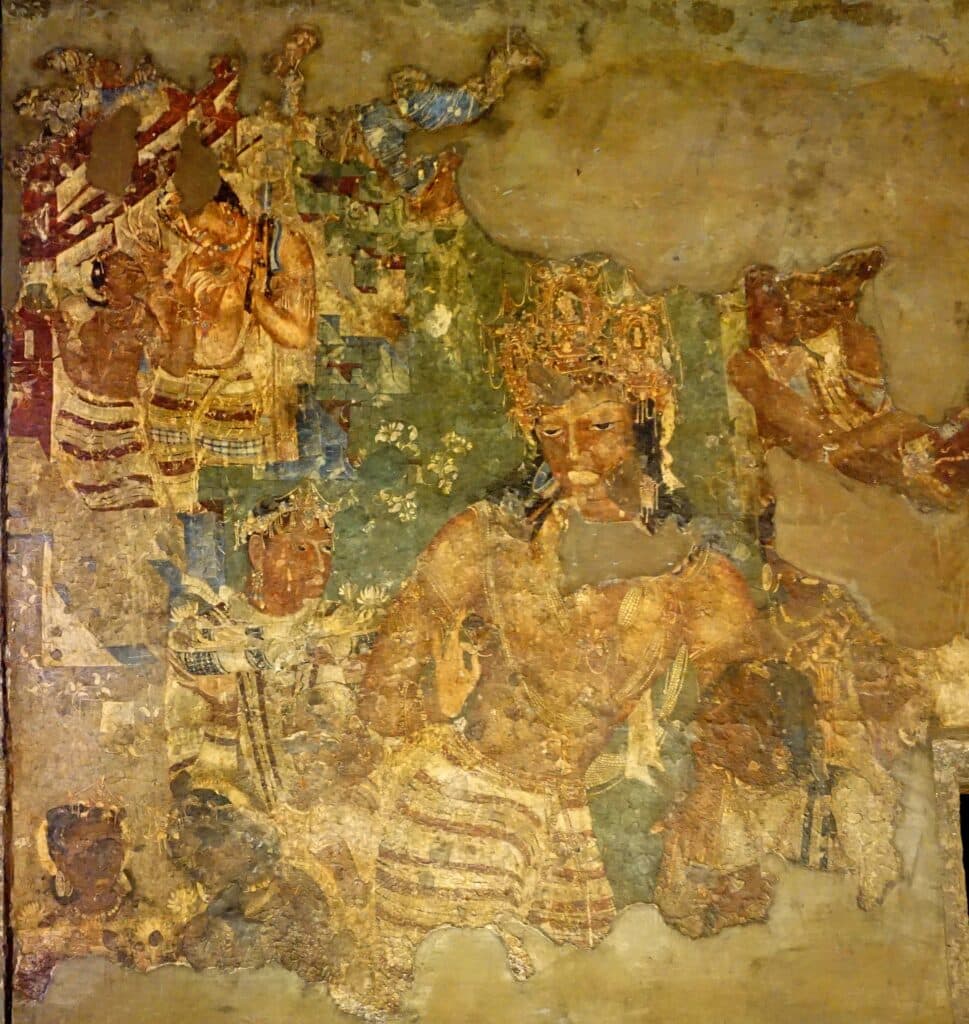
Ellora Cave Paintings
- Ellora Caves or Verul Caves are a multi-religious rock-cut cave complex with artwork dating from the period 500 BCE, located in the Aurangabad District of Maharashtra, India.
- There are over 100 caves at the site, all excavated from the basalt cliffs in the Charanandri Hills, 34 of which are open to public. These consist of 17 Hindu (caves 13–29), 12 Buddhist (caves 1–12) and 5 Jain (caves 30–34) caves.
- The mural paintings at Ellora caves are found in five caves, mostly limited to Cave No. 16, i.e., Kailasha Temple.
- It was developed under the patronage of Rashtrakuta king Krishna I and is dedicated to Lord Shiva.
- These murals were done in two phases. The first phase paintings were done during the carving of the caves, while the second phase ones were done several centuries later.
- The earlier paintings show Vishnu with his consort Lakshmi borne through the clouds by Garuda, the celestial bird. The later paintings, made in Gujarati style, depict procession of Shaiva holy men. The paintings are related to all three religoins (Buddhism, Jainism and Hinduism). Ellora Cave paintings are newer as compared to Ajanta Cave paintings.
- Some prominent Ellora cave paintings are:
- Cave No. 10 is a Buddhist Chaitya cave known as Vishwakarma Cave or carpenter’s cave wherein Buddha is seated in Vyakhyana Mudra here and Bodhi tree is carved at his back.
- Cave No. 14 is themed “Raavankikhai”.
- Cave No. 15 is Dashavatara Temple.
- Two famous Jain caves are Indra Sabha (Cave 32) and Jagannath Sabha (Cave 33).
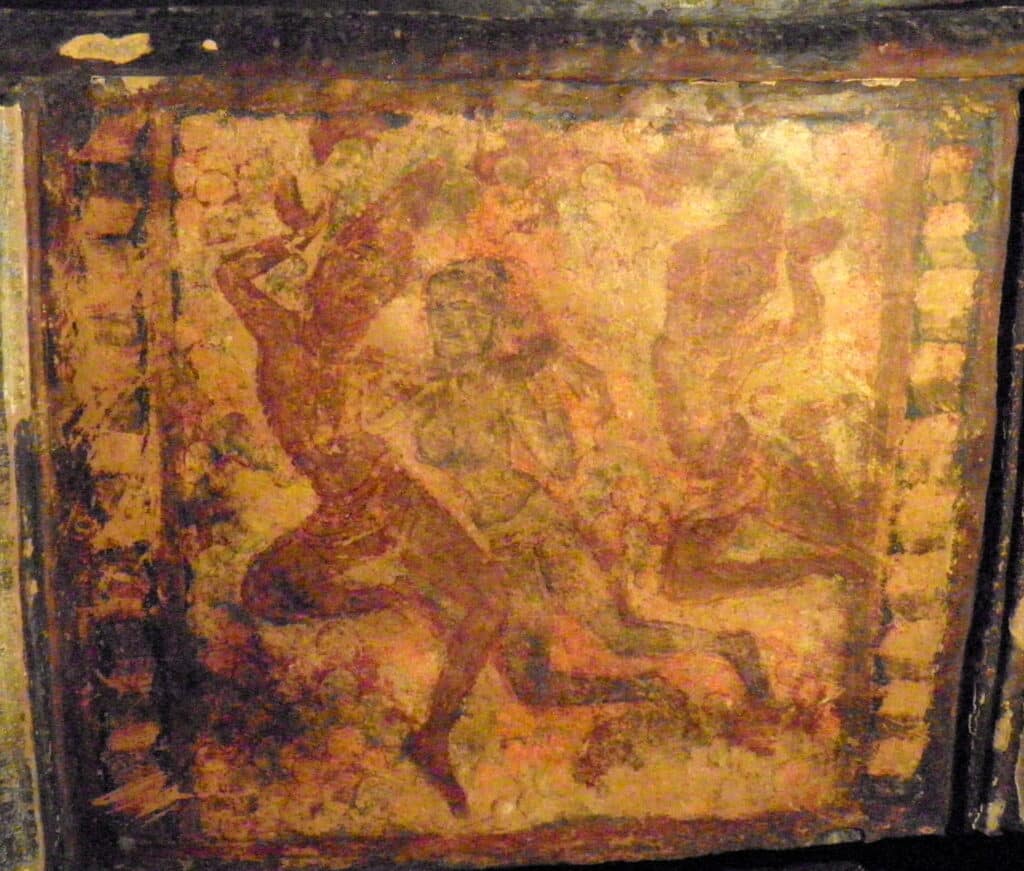
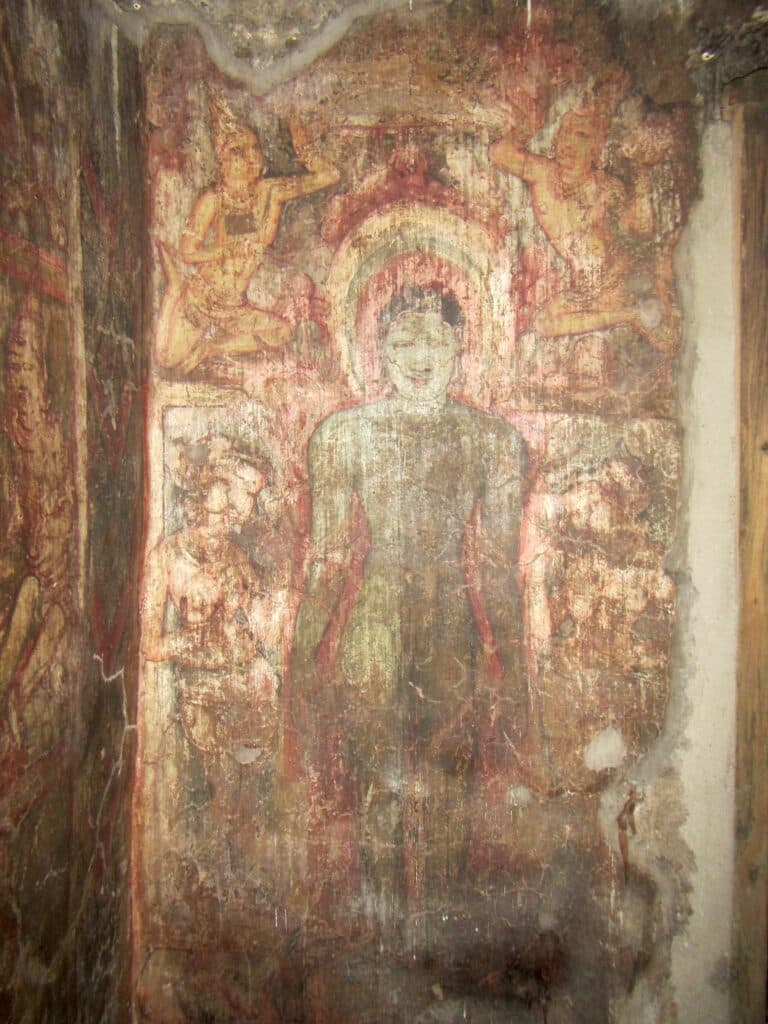
| Dimensions | Ajanta Caves | Ellora Caves |
|---|---|---|
| Location | Near Aurangabad district of Maharashtra | North West of Aurangabad district of Maharashtra |
| Timeline | Constructed between 2nd Century BCE to 6th Century CE | Constructed between 6th Century CE to 10th Century CE |
| Number of caves | 30 caves with one incomplete so sometimes considered 29. 4 Chaityas and rest Viharas. | 100 caves with 34 open for public. Caves dedicated to Hinduism are more followed by Buddhist caves. Cave 10 is the only Chaitya while rest are Viharas. |
| Religions | Entirely Buddhism | Hinduism, Buddhism and Jainism |
| Patronage | Satavahanas, Vakatakas and Chalukyas | Rashtrakutas, Kalachuris, Chalukyas and the Yadavas |
| Chronology of Construction | 2nd — 1st Century BCE – Hinayana Phase 5,h – 6th; Century CE – Mahayana Phase | 550 – 600 CE – Hindu Phase 600 – 730 CE – Buddhist Phase 730 – 950 CE – Hindu and Jain Phase |
| Major attraction | Paintings, architecture and sculptures | Architecture and sculptures. Especially the Kailashnath temple. |
Bagh Cave Paintings
- The Bagh Caves are a group of nine rock-cut monuments, situated among the southern slopes of the Vindhyas in Bagh town of Dhar district in Madhya Pradesh state in central India.
- The Bagh caves, like those at Ajanta, were excavated by master craftsmen on perpendicular sandstone rock face of a hill on the far bank of a seasonal stream, the Baghani.
- The paintings on the wall and ceilings of the Viharas of Bagh, the fragments of which are still visible in Cave 3 and Cave 4 (remnants seen also in Caves 2, 5 and 7), were executed in tempera. Cave 2 is the best preserved cave, also known as “Pandava Cave”
- These paintings are materialistic rather than spiritualistic. Characteristics of paintings are like those of Ajanta Caves.
- The main difference is that the figures are more tightly modeled, have stronger outline, and are more earthly and human.
- The ground prepared was a reddish-brown gritty and thick mud plaster, laid out on the walls and ceilings. Over the plaster, lime-priming was done, on which these paintings were executed.
- Some of the most beautiful paintings were on the walls of the portico of Cave 4. Cave No. 4, known as Rang Mahal, has beautiful murals on the walls depicting Buddhist Jataka tales, just like those in Ajanta.
- Although scanty and decayed now, these paintings depict religious themes in the light of contemporary lifestyle of people, thus are more secular in nature.
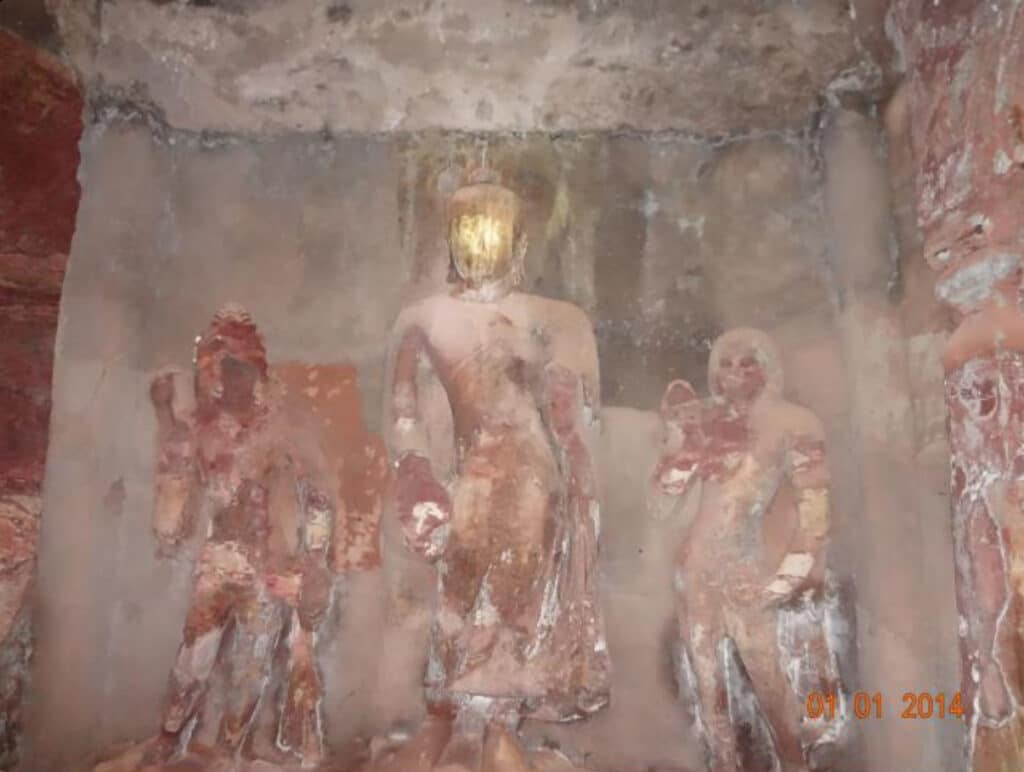
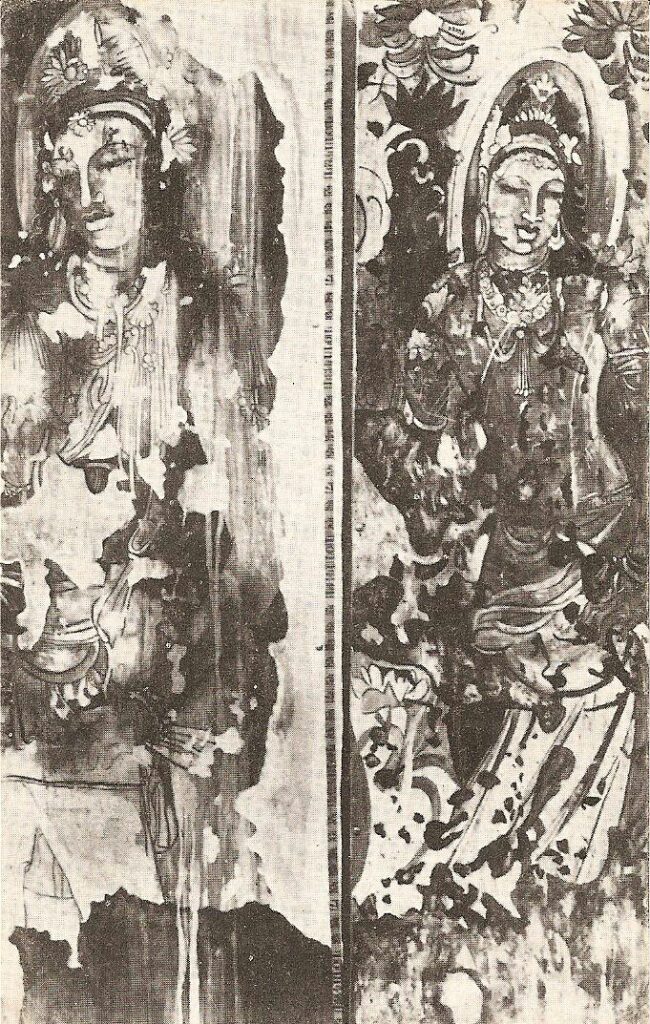

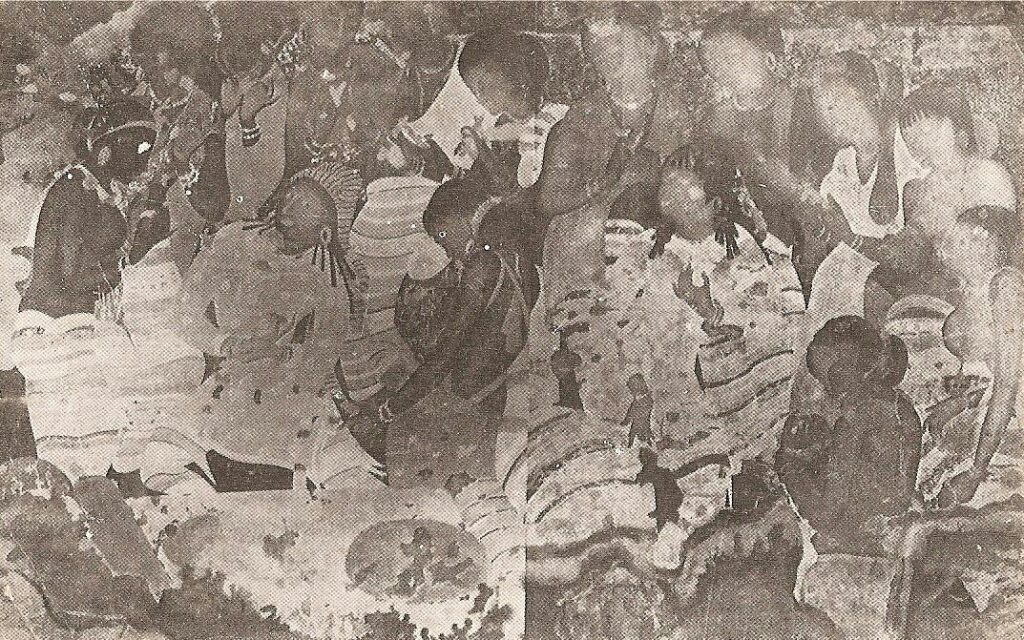
Armamalai Cave Paintings
- Situated in Vellore district of Tamil Nadu, these natural caves were converted into Jain temple in 8th century.
- Unbaked mud structures are located within the cave, which acted like the place of rest for Jain saints.
- The beautiful colourful paintings on the walls and roof depict the tales of Astathik Palakas (deities protecting eight corners) and Jainism.
- The paintings in the cave are applied by two techniques, Fresco and Tempera. They are similar to the paintings of Sittanavasal Cave, another ancient Jain cave in Tamil Nadu and Bagh Caves, an ancient Buddhist cave in Madhya Pradesh.
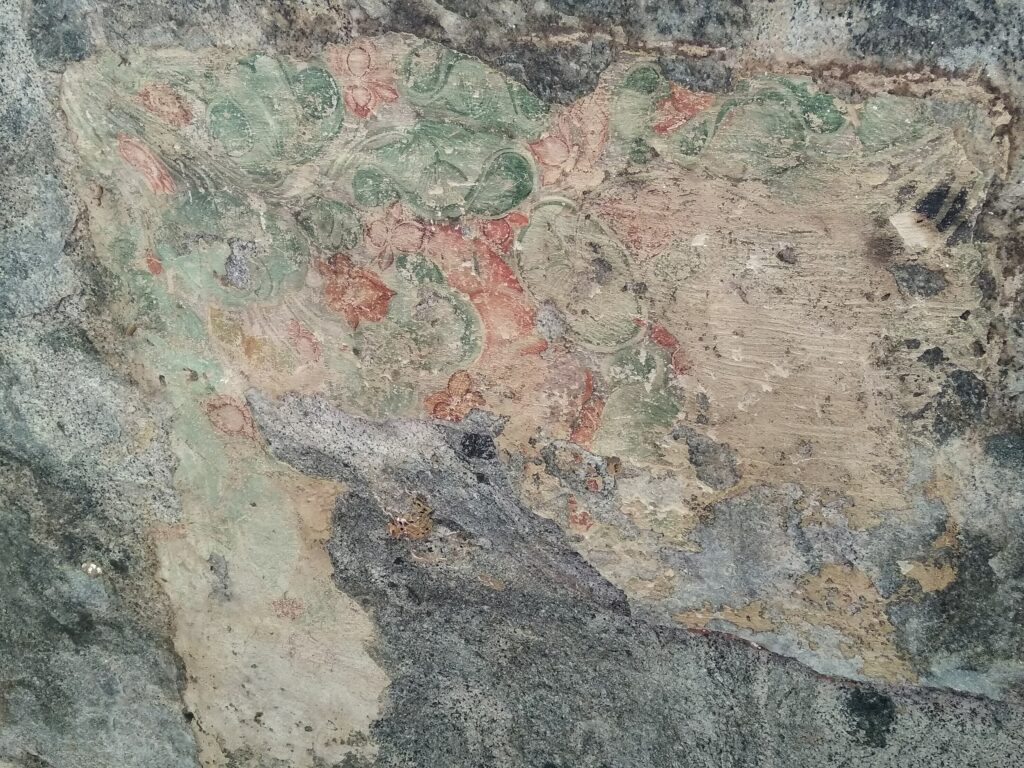
Sittanavasal Cave (Arivar Koil) Paintings
- Dated from 1st century BC to 10th century AD, and located in Tamil Nadu, these famous rock-cut cave temples are known for the paintings based on Jainism.
- These murals have close resemblance to Bagh and Ajanta paintings. The paintings are not only on the walls but also on the ceiling and pillars. The paintings are with the theme of Jain Samavasarana (Preaching hall).
- Some scholars believe that these caves belong to the Pallava period, when King Mahendravarman I excavated the temple, while others attribute them to when Pandya ruler renovated the shrine in the 7th century.
- The medium used for painting was vegetable and mineral dyes, and was done by putting colours on surface of thin wet lime plaster. The common colours included yellow, green, orange, blue, black and white.
- The central element of the paintings in Sittanavasal is a pond with lotuses. Flowers in this pond are collected by monks and there are ducks, swans, fishes and animals.
- The ceilings have depiction of a lotus tank with natural looking images of men, animals, flowers, birds and fishes representing the Samavasarana faith of Jainism. The pillars are also carved with dancing girl and the king and the queen.
- Samavasarana is a special, beautiful audience hall where Tirthankaras delivered sermons after they reached realisation (kevala-jnana). Bulls, elephants, apsaras and gods gathered in this audience hall to witness this grand scene.
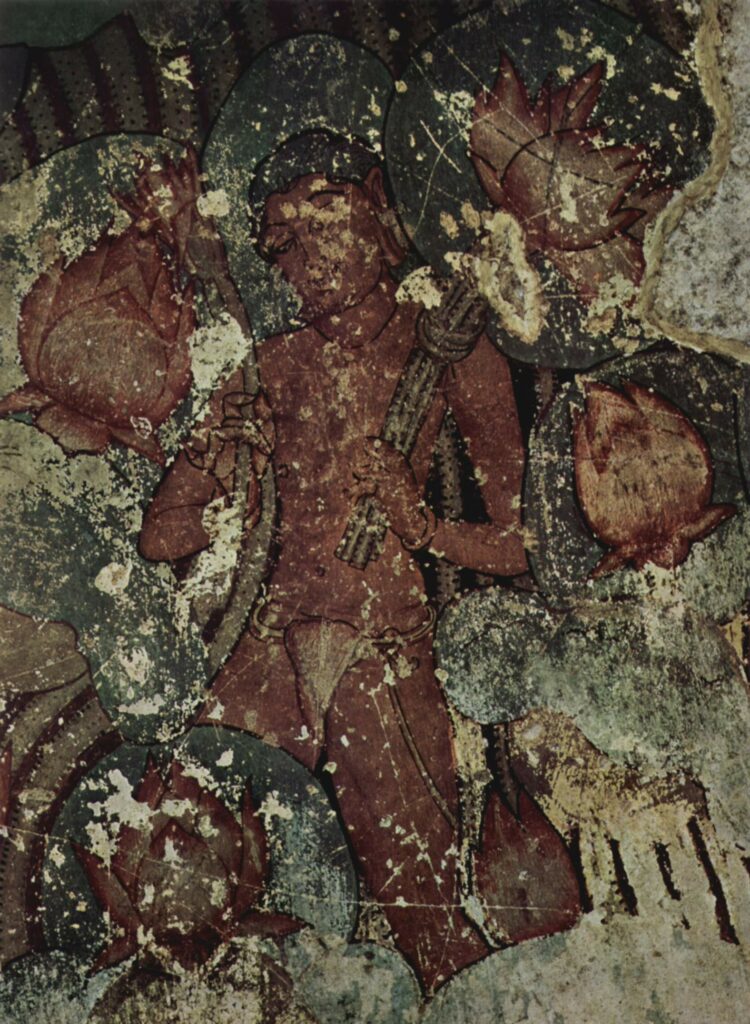
Ravan Chhaya Rock Shelter
- The Sitabhinji Group of Rock Shelters, also referred to as the Ravanachhaya Mural Rocks is located in the Keonjhar district of Odisha, these ancient fresco paintings on a rock shelter are in the shape of half-opened umbrella.
- It is believed that this shelter acted like the royal hunting lodge. The most noticeable painting is that of a royal procession that dates back to 7th century AD.
- The remains of Chola period paintings, belonging to 11th century are also of importance.
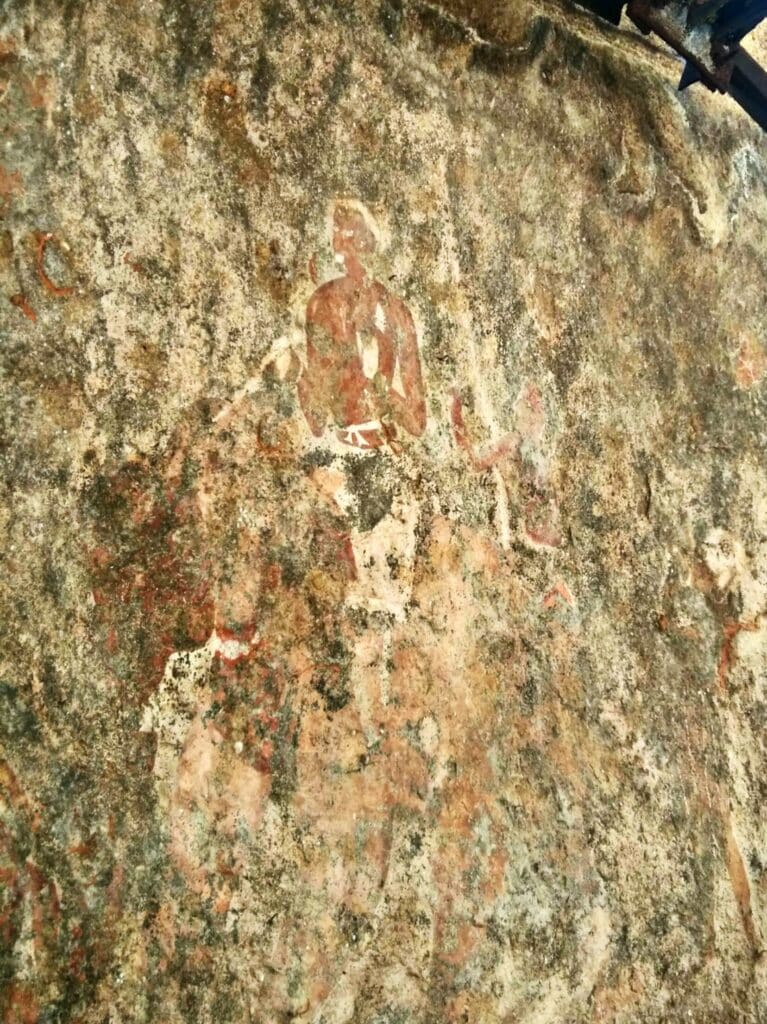
Lepakshi Temple Paintings
- Located in the Anantapur district of Andhra Pradesh, these mural paintings were executed on Veerabhadra temple walls at Lepakshi in 16th century.
- Made during the Vijayanagara period, they follow a religious theme based on Ramayana, Mahabharata and incarnations of Vishnu.
- The paintings show a complete absence of primary colours, especially blue. They depict a decline in painting in terms of quality. The forms, figures and details of their costumes are outlined with black colour.
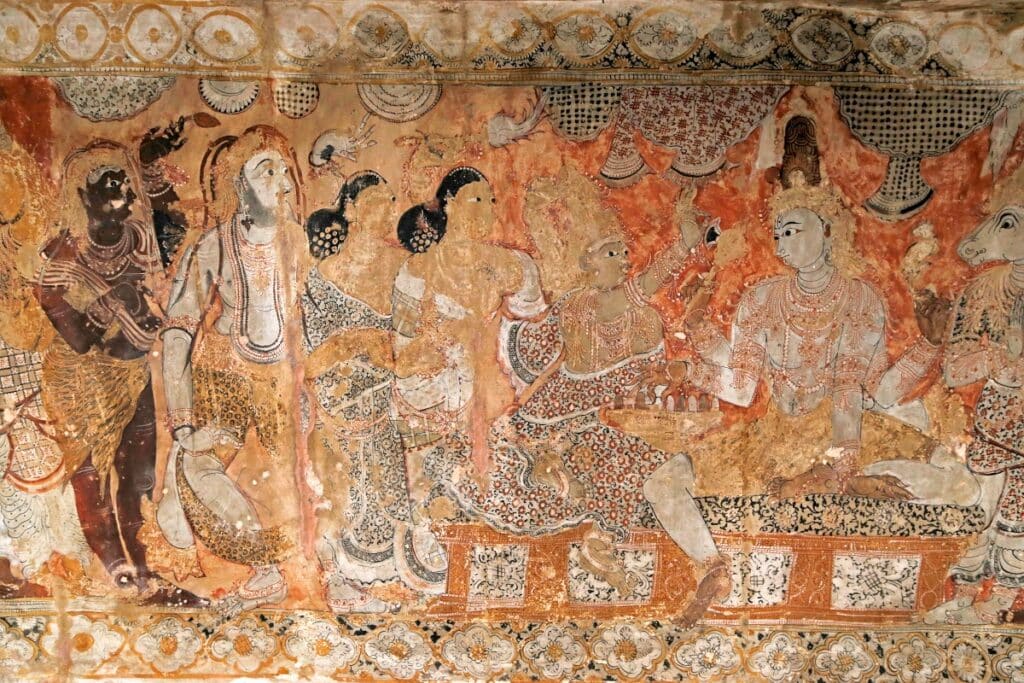
Jogimara Cave Paintings
- It is an artificially carved out cave located in Surguja district of Chattisgarh.
- It is dated back around 1000-300 BC and has few paintings and inscriptions of a love story in Brahmi script.
- The cave is said to be an attachment to amphitheatre and the paintings were made to decorate the room. Paintings are of dancing couples, of animals like elephant and fish.
- The paintings have a distinct red outline. Other colours like white, yellow and black were also used. Rock-cut theatre of Sitabenga is also located nearby.
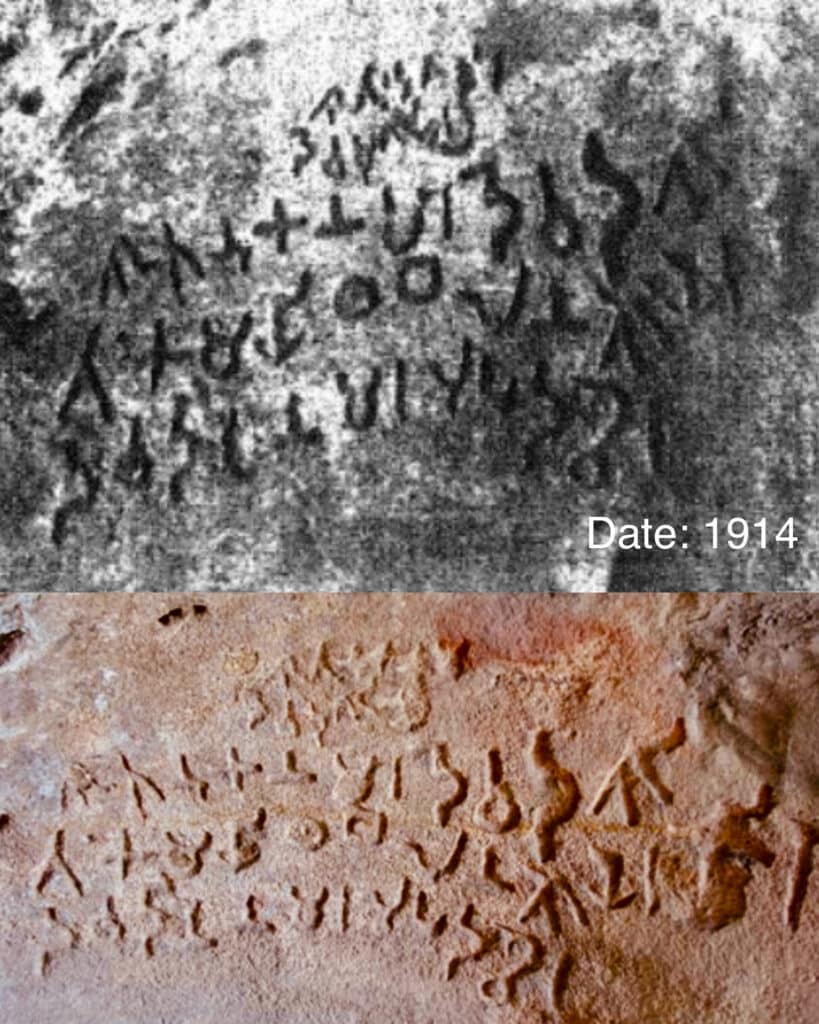
Badami Cave Paintings
- The Badami cave temples are a complex of Hindu and Jain cave temples located in Badami, a town in the Bagalkot district in northern part of Karnataka, India.
- Badami was the capital of the early Chalukyan dynasty which ruled the region from 543 to 598 CE.
- Though the Badami Cave Temples are famous for its sculptures, there are beautiful paintings too. They are one of the earliest surviving Hindu paintings.
- Many of them could not stand the effects of time yet some have reasonably survived. The paintings were completed during the period of King Mangalishwara, son of Puleksin I. The caves at Vatapi were fully decorated with murals; many of them were inspired from Puranas. The most surviving murals include the paintings of Shiva and Parvathi as well as some other characters.
- The inscription in Cave No.4 mentions the date 578–579 CE, describes the beauty of the cave and includes the dedication of the image of Vishnu.
- Paintings in this cave depict palace scenes. One shows Kirtivarman, the son of Pulakesin I and the elder brother of Mangalesha, seated inside the palace with his wife and feudatories watching a dance scene.
- The paintings found here are stylistically similar to the ones found in Ajanta
- The sinuously drawn lines, fluid forms and compact composition exemplify the proficiency and maturity the artists had achieved in the sixth century CE.
- There are 4 caves of which
- Cave 1 is oldest among the four caves. Paintings on the ceiling of the cave are of Lord Shiva as Nataraja, and Shiva and Parvati with a coiled serpent which has high aesthetic value. This is thus dedicated to Nataraja.
- Cave 2 is dedicated to Lord Vishnu and his many incarnations.
- Cave 3 is also inspired by Brahmanical forms and thus has giant figures of many avatars of Vishnu like Paravasudeva, Bhuvaraha, Harihara and Narasimha.
- Cave 4 is based on Jain ideology and it has a huge image of Lord Mahavira. It is said to be built at last at least a 100 years away from the first cave.
